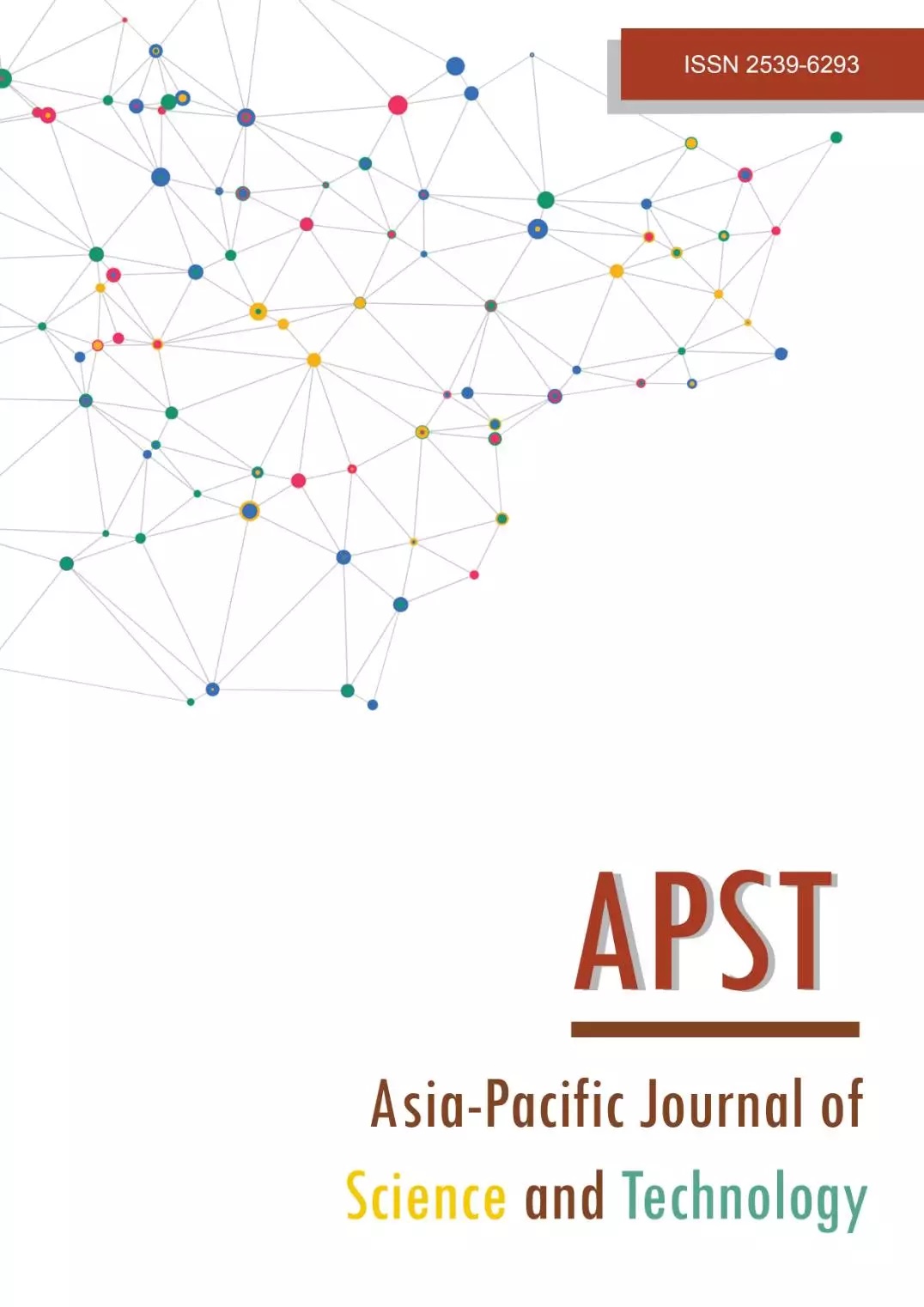Development of a cost effective customised electronic nose useful for discrimination of tea quality
Main Article Content
Abstract
This paper presents the development of a cost-effective electronic nose (E-Nose) system using five commercially available metal oxide semiconductor (MOS) sensors- TGS2600, TGS2602, TGS2610, TGS2611 and TGS2620. The developed E-Nose system was used to evaluate the quality of different black tea samples. Here, fifteen different tea samples were taken from different tea gardens for testing using the E-Nose and the Overall Liquor Rating (OLR) is obtained from the tea-taster. Further, the data collected and recorded from the E-Nose were analyzed using three machine learning techniques viz. Principal Component Analysis (PCA), Radar plot and K-Nearest Neighbors (KNN). PCA shows the variance discrimination rate of 98.77% and 96.15% for dry and infused tea samples respectively. Radar plots show the sensor TGS2620 as the most significant, whereas TGS2611 is the least significant and the sensors TGS2600, TGS2602 and TGS2610 show almost equal significance. The classification accuracy obtain from the KNN classifier is 97% and 94% for dry and infused samples respectively. The developed system is found to be a cost-effective system as compared to many other E-Nose systems available, which makes it affordable for the marginal tea farmer.
Article Details

This work is licensed under a Creative Commons Attribution-NonCommercial-NoDerivatives 4.0 International License.
References
Tozlu B, İbrahim Okumuş H, Şimşek C, Aydemir Ö. On-line monitoring of theaflavins and thearubigins ratio in turkish black tea using electronic nose. Int J Appl Sci Eng. 2015;7(5):40-49.
Saikia D, Boruah PK, Sarma U. Development and implementation of a sensor network to monitor fermentation process parameter in tea processing. Int J Smart Sens Intell Syst. 2014;7(3):1254-1270.
Sharmilan T, Premarathne I, Wanniarachchi I, Kumari S, Wanniarachchi D. Electronic Nose Technologies in Monitoring Black Tea Manufacturing Process. J Sens. 2020;(1):1-8.
Bhattacharyya N, Bandyopadhyay R, Bhuyan M, Tudu B, Ghosh D, Jana A. Electronic nose for black tea classification and correlation of measurements with ‘Tea taster’ marks. IEEE Trans Instrum Meas. 2008;57(7):1313-1321.
Teshome K. Effect of tea processing methods on biochemical composition and sensory quality of black tea (Camellia sinensis (L.) O. Kuntze): a review. J Hortic For. 2019;11(6):84-95.
Karakaya D, Ulucan O, Turkan M. Electronic nose and its applications: a survey. Int J Autom Comput. 2020;17(2):179-209.
Saha P, Ghorai S, Tudu B, Bandyopadhyay R, Bhattacharyya N. Multiclass kernel classifiers for quality estimation of black tea using electronic nose. In: Mason A, Mukhopadhyay SC. Jayasundera KP, Bhattacharyya N, editors. Sensing technology: current status and future trends II. New york: Springer; 2014. p. 141-160.
Banerjee R, Bandyopadhyay R, Tudu B, Bhattacharyya N. Tea and the use of the electronic nose. In: Méndez MLR, Preedy VR, editors. Electronic noses and tongues in food science. 1st ed. Massachusetts: Academic Press; 2016. p. 125-135.
Bhattacharyya N, Seth S, Tudu B, Tamuly P, Jana A, Ghosh D, et al. Detection of optimum fermentation time for black tea manufacturing using electronic nose. Sens Actuators B Chem. 2007;122(2):627-634.
Zou G, Xiao Y, Wang M, Zhang H. Detection of bitterness and astringency of green tea with different taste by electronic nose and tongue. PLoS One. 2018;13(12):e0206517.
Dutta R, Kashwan KR, Bhuyan M, Hines EL, Gardner JW. Electronic nose based tea quality standardization. Neural Netw. 2003;16:847-853.
Xu M, Wang J, Zhu L. The qualitative and quantitative assessment of tea quality based on E-nose, E-tongue and E-eye combined with chemometrics. Food Chem. 2019;289:482-489.
Tang X, Xiao W, Shang T, Zhang S, Han X, Wang Y, et al. An Electronic nose technology to quantify pyrethroid pesticide contamination in tea. Chemosensors. 2020;8(2):30.
Saikia D, Boruah PK, Sarma U. A Sensor network to monitor process parameters of fermentation and drying in black tea production. MAPAN. 2015;30:211-219.
Saikia D, Sarma DK, Boruah, PK, Sarma U. Studies on Correlation between tea process parameters and overall liquor rating using MLR and ANN based technique. J Basic Appl Eng Res. 2015;2(19):1688-1692.
Lu X, Wang J, Lu G, Lin B, Chang M, HE W. Quality level identification of West Lake Longjing green tea using electronic nose. Sens Actuators B Chem. 2019;301:127056.
Yunusa Z, Hamidon MN, Kaiser A, Awang Z. Gas sensors: a review. Sens Transducers. 2014;168(4):61-75.
Buyukgoz GG, Soforoglu M, Basaran Akgul N, Boyaci IH. Spectroscopic fingerprint of tea varieties by surface enhanced Raman spectroscopy. J Food Sci Techno. 2016;53(3):1709-1716.
Tozlu BH, Okumuş Hİ. A new approach to automation of black tea fermentation process with electronic nose. Automatika. 2018;59(3):373-381.
Sharmilan T, Premarathne I, Wanniarachchi I, Kumari S, Wanniarachchi D. Electronic nose technologies in monitoring black tea manufacturing process. J Sens. 2020;(1):1-8.
Hidayat SN, Triyana K, Fauzan I, Julian T, Lelono D, Yusuf Y, et al. The electronic nose coupled with chemometric tools for discriminating the quality of black tea samples in situ. Chemosensors. 2019;7(3):29.
Thriumani R, Zakaria A, Hashim YZHY, Jeffree AI, Helmy KM, Kamarudin LM, et al. A study on volatile organic compounds emitted by in-vitro lung cancer cultured cells using gas sensor array and SPME-GCMS. BMC Cancer. 2018;18(1):362.
Khatun H, Hazarika S, Sarma U. Aluminium plate surface defect detection and classification based on piezoelectric transducers. In: Kalra R, editor. The 18th India Council International Conference (INDICON); 2021 Dec 19-21; Guwahati, India. New york: IEEE; 2021. p. 1-6.


